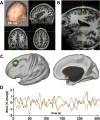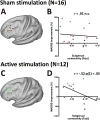Prospective Validation That Subgenual Connectivity Predicts Antidepressant Efficacy of Transcranial Magnetic Stimulation Sites
- PMID: 29274805
- PMCID: PMC6091227
- DOI: 10.1016/j.biopsych.2017.10.028
Prospective Validation That Subgenual Connectivity Predicts Antidepressant Efficacy of Transcranial Magnetic Stimulation Sites
Abstract
Background: The optimal target in the dorsolateral prefrontal cortex for treating depression with repetitive transcranial magnetic stimulation (rTMS) remains unknown. Better efficacy has been associated with stimulation sites that are 1) more anterior and lateral and 2) more functionally connected to the subgenual cingulate. Here we prospectively test whether these factors predict response in individual patients.
Methods: A primary cohort (Boston, n = 25) with medication-refractory depression underwent conventional open-label rTMS to the left dorsolateral prefrontal cortex. A secondary cohort (Michigan, n = 16) underwent 4 weeks of sham followed by open-label rTMS for nonresponders (n = 12). In each patient, the location of the stimulation site was recorded with frameless stereotaxy. Connectivity between each patient's stimulation site and the subgenual cingulate was assessed using resting-state functional connectivity magnetic resonance imaging from a cohort of healthy subjects (n = 1000) and confirmed using connectivity from patients with depression (n = 38).
Results: In our primary cohort, antidepressant efficacy was predicted by stimulation sites that were both more anterolateral (r = .51, p < .01) and more negatively correlated with the subgenual cingulate (r = -.55, p < .005). However, subgenual connectivity was the only independent predictor of response and the only factor to predict response to active (r = -.52, p < .05) but not sham rTMS in our secondary cohort.
Conclusions: This study provides prospective validation that functional connectivity between an individual's rTMS cortical target and the subgenual cingulate predicts antidepressant response. Implications for improving the cortical rTMS target for depression are discussed.
Keywords: Depression; Dorsolateral prefrontal cortex; Resting-state functional connectivity; Subgenual cingulate; TMS; Transcranial magnetic stimulation.
Copyright © 2017 Society of Biological Psychiatry. Published by Elsevier Inc. All rights reserved.
Conflict of interest statement
All other authors report no biomedical financial interests or potential conflicts of interest. The authors declare no competing interests.
Figures




Comment in
-
Where to Target? The Precision Medicine Approach to Brain Stimulation.Biol Psychiatry. 2018 Jul 1;84(1):e1-e2. doi: 10.1016/j.biopsych.2018.04.010. Biol Psychiatry. 2018. PMID: 29929580 No abstract available.
Similar articles
-
Changes in brain connectivity during a sham-controlled, transcranial magnetic stimulation trial for depression.J Affect Disord. 2018 May;232:143-151. doi: 10.1016/j.jad.2018.02.019. Epub 2018 Feb 21. J Affect Disord. 2018. PMID: 29494898 Free PMC article.
-
Efficacy of transcranial magnetic stimulation targets for depression is related to intrinsic functional connectivity with the subgenual cingulate.Biol Psychiatry. 2012 Oct 1;72(7):595-603. doi: 10.1016/j.biopsych.2012.04.028. Epub 2012 Jun 1. Biol Psychiatry. 2012. PMID: 22658708 Free PMC article.
-
Association of Repetitive Transcranial Magnetic Stimulation Treatment With Subgenual Cingulate Hyperactivity in Patients With Major Depressive Disorder: A Secondary Analysis of a Randomized Clinical Trial.JAMA Netw Open. 2019 Jun 5;2(6):e195578. doi: 10.1001/jamanetworkopen.2019.5578. JAMA Netw Open. 2019. PMID: 31167023 Free PMC article.
-
[Repetitive transcranial magnetic stimulation in major depression: response factor].Encephale. 2012 Sep;38(4):360-8. doi: 10.1016/j.encep.2011.08.004. Epub 2011 Oct 11. Encephale. 2012. PMID: 22980479 Review. French.
-
Targeting repetitive transcranial magnetic stimulation in depression: do we really know what we are stimulating and how best to do it?Brain Stimul. 2021 May-Jun;14(3):730-736. doi: 10.1016/j.brs.2021.04.018. Epub 2021 Apr 30. Brain Stimul. 2021. PMID: 33940242 Review.
Cited by
-
Converging Resting State Networks Unravels Potential Remote Effects of Transcranial Magnetic Stimulation for Major Depression.Front Psychiatry. 2020 Aug 20;11:836. doi: 10.3389/fpsyt.2020.00836. eCollection 2020. Front Psychiatry. 2020. PMID: 32973580 Free PMC article.
-
Opportunities of connectomic neuromodulation.Neuroimage. 2020 Nov 1;221:117180. doi: 10.1016/j.neuroimage.2020.117180. Epub 2020 Jul 20. Neuroimage. 2020. PMID: 32702488 Free PMC article. Review.
-
Neuromodulatory transcranial magnetic stimulation (TMS) changes functional connectivity proportional to the electric-field induced by the TMS pulse.Clin Neurophysiol. 2024 Sep;165:16-25. doi: 10.1016/j.clinph.2024.06.007. Epub 2024 Jun 19. Clin Neurophysiol. 2024. PMID: 38945031
-
Intrinsic Brain Network Biomarkers of Antidepressant Response: a Review.Curr Psychiatry Rep. 2019 Aug 13;21(9):87. doi: 10.1007/s11920-019-1072-6. Curr Psychiatry Rep. 2019. PMID: 31410661 Free PMC article. Review.
-
Lead-DBS v2: Towards a comprehensive pipeline for deep brain stimulation imaging.Neuroimage. 2019 Jan 1;184:293-316. doi: 10.1016/j.neuroimage.2018.08.068. Epub 2018 Sep 1. Neuroimage. 2019. PMID: 30179717 Free PMC article.
References
-
- Mayberg HS, Lozano AM, Voon V, McNeely HE, Seminowicz D, Hamani C, et al. Deep brain stimulation for treatment-resistant depression. 2005;45:651–660. - PubMed
-
- Brody AL, Saxena S, Mandelkern MA, Fairbanks LA, Ho ML, Baxter LR. Brain metabolic changes associated with symptom factor improvement in major depressive disorder. BPS. 2001;50:171–178. - PubMed
-
- Mayberg HS, Liotti M, Brannan SK, McGinnis S, Mahurin RK, Jerabek PA, et al. Reciprocal limbic-cortical function and negative mood: converging PET findings in depression and normal sadness. Am J Psychiatry. 1999;156:675–682. - PubMed
-
- Mayberg HS, Brannan SK, Tekell JL, Silva JA, Mahurin RK, McGinnis S, Jerabek PA. Regional metabolic effects of fluoxetine in major depression: serial changes and relationship to clinical response. BPS. 2000;48:830–843. - PubMed
-
- Biver F, Goldman S, Delvenne V, Luxen A, De Maertelaer V, Hubain P, et al. Frontal and parietal metabolic disturbances in unipolar depression. BPS. 1994;36:381–388. - PubMed
Publication types
MeSH terms
Substances
Grants and funding
LinkOut - more resources
Full Text Sources
Other Literature Sources
Medical
Molecular Biology Databases

